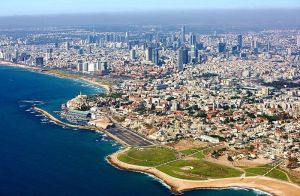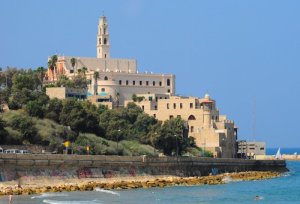(This post was written on May 29. It just took a while to post it.)
Walking in knee-deep water
through a damp, darkened tunnel was the high point of today.
Perhaps I should
explain.
Our focus today
was on a few important aspects of the City of Jerusalem, in both its modern
incarnation and its historical development.
To start the
day, we took a tour of East Jerusalem and its various Jewish and Muslim
neighborhoods with a group called Ir Amim. Our guide, Yaniv, was fantastic, but even he was not able to make the tour anything less than sobering. Though come to think of it, sobering is probably exactly what it should have been.
 |
| Yaniv, tellin' it like it is. |
The issue, according to Ir Amim, is this: broadly speaking, the expansion of
Jewish neighborhoods in East Jerusalem (“Settlements”) has the potential to
block any and all progress toward a two-state solution. As Danny Seidemann
said in our discussion with him yesterday, it is probably necessary, if one is interested in a two-state
solution, to be able to draw a single-line border between the Jewish and
Palestinian areas of Jerusalem. The tour today showed that the continued growth
and expansion of East Jerusalem settlements is likely to make drawing that border impossible.
Indeed, the consensus within (the admittedly left-leaning) Ir Amim is that this
undermining of the two-state solution is and has been deliberately planned by various Israeli governments to do just that. That is, by changing the “facts on the ground”
and making a contiguous Palestinian state impossible in East Jerusalem, some
leaders in Israeli politics hope to forestall giving any concessions to
Palestinians, and maintaining Jerusalem as a unified city under Israeli
control.
 |
| In the foreground, all of us. In the background, existential despair. |
This strategy
strikes me as short-sighted. It seems to me that making Jerusalem indivisible
has the potential to backfire. Given Israel’s geographic position, being
surrounded by Arab states, it seems unwise to value territorial unity over
peace. While Israel is certainly in a dominant regional position militarily,
this may not always be the case. And, if Israel were ever to fall behind,
making Jerusalem indivisible could result in stranding Jewish neighborhoods
under Palestinian rule, rather than vice-versa, as seems to be the plan at the
moment. Of course, many would describe any willingness to compromise the territorial integrity of Israel as short-sighted as well. They would probably argue that, since conflict is, as they see it, inevitable, giving any concessions only weakens the nation in the long run.
Huh. It's almost like this problem isn't easy to solve.
On a lighter
note, the second half of our day was spent at the City of David. The City of
David is the name given to the archaeological site of the ancient City of
Jerusalem, as it existed under the biblical Kings of Israel. Interestingly, the modern site of the City of David is in the Palestinian neighborhood of Silwan. We began with a
video explaining the history of the city through various periods. Much of this
was informative, but it was rather undercut by persistent, if low-key,
promotion of the idea that modern Israel is a direct continuation of that
biblical kingdom. After the video, we went on a brief tour of the site,
including a few interesting facts about how the ancient Israelites lived. It’s
amazing how much you can find out by examining the archaeological remains of a
toilet, apparently.
But the high point of the visit to the City of David was
traveling through King Hezekiah’s Tunnel. This tunnel, designed to provide a
larger water supply to Jerusalem in the case of siege or invasion, was a lot of
fun. It still functions today, and we walked through the entirety of it in about half an hour. It's about half a mile long, and the water still runs through it. While the water stayed
mostly around mid-shin height, there were a couple moments where it reached a
bit higher. At its highest point, it came up to about the middle of my thigh.
I’m fairly tall, though, so others were rather more inconvenienced. Knowing the water might be a problem, we didn't bring our cameras, so unfortunately there's no pictures.
 |
| It was a lot like this, only damp. |
If you want to know what it's like going through the tunnel, there are two ways you can have a similar experience right in your very own home. If you're short, just close your eyes and sit fully clothed in a half-full bathtub. If you're tall, you can do the same thing, except you kneel in the tub and smash your head against the wall. (The ceiling was a bit low at points). In all seriousness, however, it has to be said that the experience was well worth a couple of light bruises or a damp pair of shorts.
The journey through the tunnel was a cool and cooling break from the very interesting,but kind of depressing tour with Ir Amim, as well as the not inconsiderable heat of the day. All in all, today was a good blend of the serious and the fun, as well as the modern and the historic.
.jpg)























